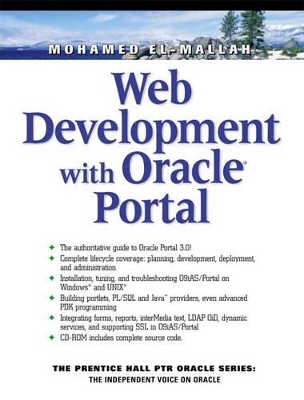
Web Development with Oracle Portal
Prentice Hall
978-0-13-060037-0 (ISBN)
- Titel ist leider vergriffen;
keine Neuauflage - Artikel merken
This book will teach any Oracle Web developer how to build Web applications using Oracle Portal, the successor product to Oracle's popular WebDB 2.2. It covers the entire lifecycle, from product installation on Windows NT/2000 and Linux through configuration, capacity planning, development, integration, deployment, and administration. Oracle Portal specialist Mohamed El-Mallah introduces every key concept and technique Oracle Web developers need to master, including site component construction, creating and managing portlets (the basic components of a portal), working with Oracle Portal's site administration tools, and more. The book's advanced coverage includes techniques for integrating Java and XML data providers. Throughout the book, developers will construct a complete sample application; this application is provided on the accompanying CD-ROM and also available on the Web as a live demo. This book is for all Oracle Web developers, including beginning developers without Oracle Portal or WebDB knowledge; intermediate developers upgrading from WebDB 2.x; and all Oracle Portal/WebDB users who need to master the product's new portal, Java, and XML support.
The book is also for Oracle DBAs of all levels who are responsible for WebDB installation, configuration, tuning, and/or capacity planning in either Windows or Linux environments.
MOHAMED EL-MALLAH, B.S. in Computer Science, Master of Science in Software Engineering, works for Oracle, where he specializes in O9i Application Server/Oracle Portal, Oracle Forms, Oracle Reports, and Oracle Database Administration. He has been teaching Oracle courses at the University of California, San Diego for over 3 years. He is an Oracle Certified Professional DBA and Developer.
Preface.
Acknowledgments.
I. GETTING STARTED.
1. Introduction to Portals.
Introduction. Why Do You Need a Portal? What Is an EIP? Why Oracle Portal? Oracle internet Application Server. Oracle Portal Architecture. Portal Development Cycle.
2. Installing Oracle9i Application Server and Configuring Oracle Portal on Microsoft Windows NT/2000.
Introduction. Getting Prepared. Database Installation. Configuring a Database for Oracle Portal. Oracle Portal Installation.
3. Building Your First Portal.
Introduction. Creating Your First Page. Displaying Oracle Portal Pages.
4. Oracle Portal Navigator.
Introduction. Pages Navigation. Content Areas Navigation. Applications Navigation. Database Objects Navigation.
II. BUILDING APPLICATION COMPONENTS AND CONTENT AREAS.
5. Forms and Reports.
Introduction. What Is an Application Component? Create a New Schema. Create a New Application. Create a Form Component. Create a Report Component.
6. Charts, Calendars, Dynamic Pages, Hierarchies, Menus, and Frame Drivers.
Introduction. Create a Chart Component. Create a Calendar. Create a Dynamic Page. Create a Hierarchy. Create a Menu. Create a Frame Driver.
7. Links, List of Values, and Shared Components.
Introduction. Create a Link. Create a List of Values. Shared Components.
8. Introduction to Content Areas.
Introduction. What Is a Content Area? Create Your First Content Area. Create Your First Item. Create Your First Folder. Publishing Folders. Content Area Page. Default Items Types and Attributes. Extending Item Types.
9. Content Area Administration.
Introduction. Default Folder Types. Creating Custom Folder Types. Oracle Portal Search. Publishing Categories. Publishing Perspectives. Basic Search. Advanced Search. Publishing a Search Portlet. Navigation Bar. Content Area Styles.
III. ADVANCED FEATURES OF ORACLE PORTAL.
10. Event Handling.
Introduction. JavaScript in Oracle Portal. PL/SQL Event Handling. Accessing Form Items in JavaScript. Introduction to JavaScript.
11. Advanced Page Customization.
Introduction. Create a Page Layout. Create a Page Style. Creating Pages.
12. Security in Oracle Portal.
Introduction. User Account Information. Portal Security Architecture. Content Area Security. Folder Security. Item Level Security. Navigation Bar Security. Page Security. Portal Applications Security. Application Components Security. Portlets Security.
13. Building PL/SQL Database Providers.
Introduction. Portlet Implementations. Portlet Provider Tasks. Provider Development Life Cycle. PL/SQL Database Providers. Create Your First PL/SQL Database Provider.
14. Advanced Portlet Programming.
Introduction. Portlet HTML Display Guidelines. Portal Framework Services.
15. Portal Development Kit and Web Providers.
Introduction. The Portal Development Kit. The Web Provider Architecture. Implementing a Web Portlet Using Java Servlets. Implementing a Web Portlet using JSP.
16. Integrating Oracle Products into Oracle9iAS Portal.
Introduction. Integrating Oracle9iAS Forms. Installing and Configuring O9iAS Form Services. Creating a Content Area for the Form. Add the Form Portlet to a Page. Integrating Oracle9iAS Reports. Installing and Configuring O9iAS Report Services. Integration Discoverer. Oracle Internet Directory LDAP Authentication. Configuring O9iAS Portal for External Authentication.
IV. ORACLE PORTAL FOR THE DBA.
17. Installing Oracle9iAS and Configuring Oracle Portal on Unix.
Introduction. Database Installation. O9i AS Installation.
18. Oracle Portal Administration and Migration.
Introduction. Administration Scripts. Oracle Portal Migration. Dynamic Services in Oracle Portal.
19. Scaling and Tuning Oracle9iAS Portal.
Introduction. Distributed Oracle Portal Installation. O9iAS Performance Tuning.
V. ORACLE9I APPLICATION SERVER/PORTAL FAQS AND TROUBLESHOOTING.
20. Installation and Configuration.
Introduction.
21. Development.
Introduction.
VI. APPENDICES.
Appendix A: Oracle Portal Glossary.
Appendix B: Importing the CD-ROM Portal Application, Content Area, and Page.
Introduction. Installation Steps. Installation and Troubleshooting Tips.
Index.
| Erscheint lt. Verlag | 24.10.2001 |
|---|---|
| Verlagsort | Upper Saddle River |
| Sprache | englisch |
| Maße | 179 x 235 mm |
| Gewicht | 1196 g |
| Themenwelt | Informatik ► Datenbanken ► Oracle |
| Mathematik / Informatik ► Informatik ► Web / Internet | |
| ISBN-10 | 0-13-060037-7 / 0130600377 |
| ISBN-13 | 978-0-13-060037-0 / 9780130600370 |
| Zustand | Neuware |
| Informationen gemäß Produktsicherheitsverordnung (GPSR) | |
| Haben Sie eine Frage zum Produkt? |